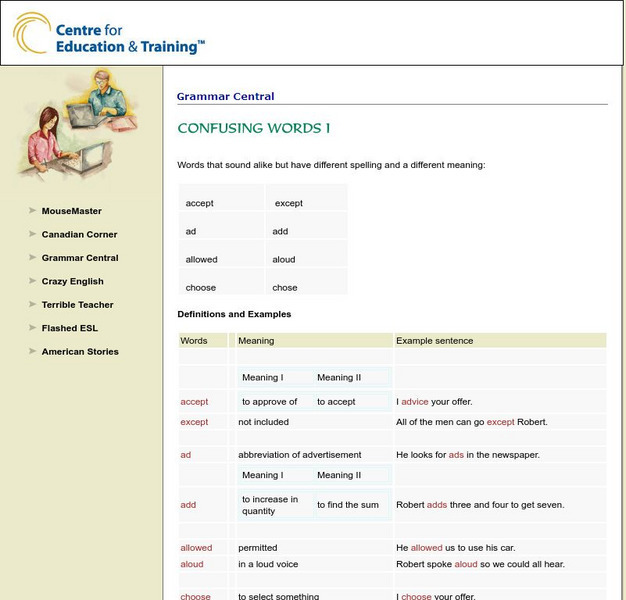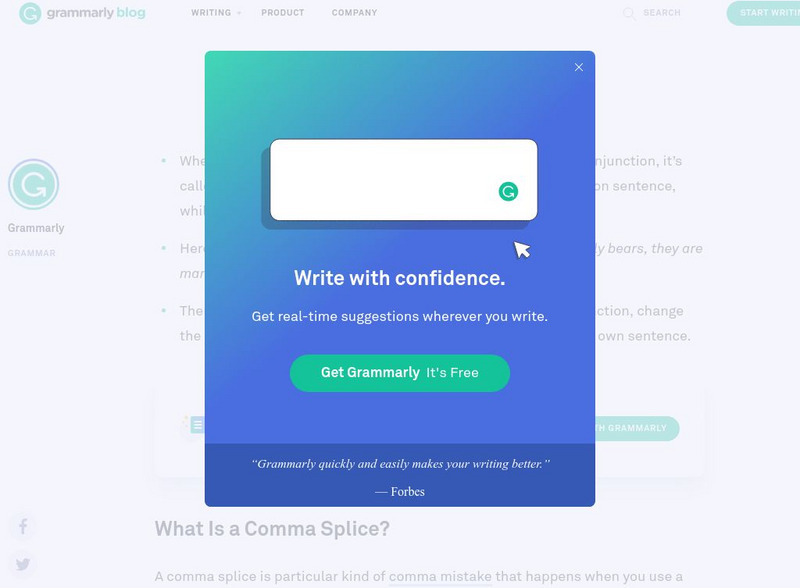Capital Community College Foundation
Guide to Grammar and Writing: Sentence Combining Skills
Students sometimes have difficulty learning to combine sentences correctly and effectively. This site discusses several methods and provides practice opportunities and quizzes.
California State University
California State University Domingues Hills: Comma Usage: Introductory Phrases
This fifteen-item instructional activity will help you determine how well you understand how to use commas with introductory elements in a sentence.
Other
Linc Home Study: Grammar Central: Confusing Words 1
This is a tutorial for words that sound alike but are spelled differently and have different meanings.
The Tongue Untied
University of Oregon the Tongue Untied: Semicolon
Discover more about semicolon usage when you visit this informative resource. Students and teachers will benefit from the examples listed for semicolon use.
E Reading Worksheets
E Reading Worksheets: End Mark Worksheets
In this learning module, students will learn more about end marks and the four types of sentences. Worksheets are provided to reinforce the four types of sentences and punctuation marks. This module is designed to support Tier I, Tier...
Soft Schools
Soft Schools: Commas in Dates Quiz
Rules for comma use in dates are simple. Review them here, then take the quiz to assess understanding.
Khan Academy
Khan Academy: Punctuation: Comma and Apostrophe: Introduction to the Possessive
Five self-correcting quiz questions over possessive pronouns.
Other
Spelling Rules: Words Ending in Y
Chart with rules and examples for adding suffixes to words that end in -y.
Grammarly
Grammarly Blog: Apostrophe Rules
This page focuses on the rules for the uses and misuses of the apostrophe including contractions and omissions, possessive nouns, possessive pronouns, how to write joint possession, plurals, apostrophes with surrounding punctuation, and...
Grammarly
Grammarly Blog: Comma
This page focuses on comma use; it explains the importance of the comma and provides an example of how drastically a comma can change the meaning of a sentence. It also provides links to 38 different pages of comma rules and examples.
Grammarly
Grammarly Blog: What Is a Comma?
This page explains that a comma is a "soft stop" in writing and provides examples of its use.
Grammarly
Grammarly Blog: Comma Usage
This page focuses on some of uses for commas and provides examples of each. These rules include separating items in a series, separating repeating words, to offset information, noun of address, and even change nouns to verbs.
Grammarly
Grammarly Blog: Comma Between Two Nouns in a Compound Subject or Object
This page focuses on the misuse of a comma by placing one between the two nouns in a compound subject or object. It provides examples of its misuse and explains why it is not correct.
Grammarly
Grammarly Blog: When to Use Commas and When Not
This page focuses on the uses and misuses of commas. It provides examples of comma uses and explains when the commas are unnecessary.
Grammarly
Grammarly Blog: Comma Within a Comparison
This page focuses on the misuse of a comma by separating the two items being compared. No comma is needed before the conjunction in a comparison unless it includes a non-restrictive clause. Examples of both are provided.
Grammarly
Grammarly Blog: Spelling Words With Double Consonants
Spelling rules and examples for words with double consonants in both single and multiple syllable words. L.11-12.2b Spelling
Grammarly
Grammarly Blog: Every Time
This page explains and provides the rules for use of the two-word compound "every time."
Grammarly
Grammarly Blog: Spelling
An explanation of the importance of spelling. Links to additional information about specific spelling rules are provided.
Grammarly
Grammarly Blog: Comma Between Correlative Conjunction Sets
This page provides the rules and exceptions for the use of commas when using corratative conjuction sets such as either or, or neither nor, or not only but also. No commas are needed between them unless the comma is needed for other...
Grammarly
Grammarly Blog: Sometime, Sometimes, and Some Time
An explanation with examples of using the words "sometime," "sometimes," and "some time" correctly in sentences.
Grammarly
Grammarly Blog: Comma Before But
This page focuses on the use of a comma before the coordinating conjunction "but" only if it is in front of an independent clause. Examples of proper and improper uses are provided.
Grammarly
Grammarly Blog: Comma in Dates
This page focuses on the use of commas when writing dates; a comma is used to separate the day from the month, and the date from the year. Examples are provided.
Grammarly
Grammarly Blog: Comma After Question Mark
This page explains how to puctuate a direct quotation that ends in a question mark or an explanation point. If the quote comes before the attributive tag, no comma is needed; if the attributive tag comes before the quote, a comma is...
Grammarly
Grammarly Blog: Comma Splice
This page focuses on the misuse of commas by using them to connect two independent clauses, resulting in a comma splice. It offers examples and suggestions for correcting them. It also provides exceptions to the rule with examples.
























